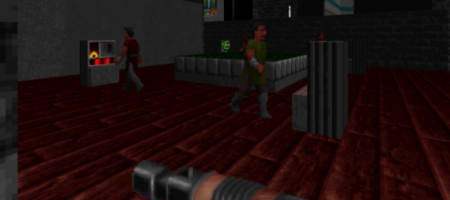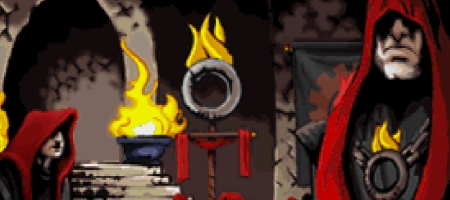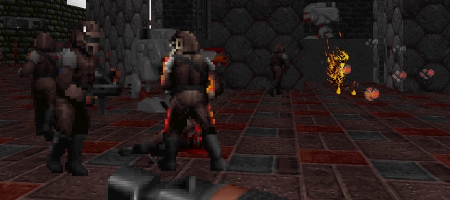Rose Tinted Retro – Strife
A short backdrop narrative slideshow, and a difficulty screen later, and Strife quickly drops you in it: An angry machine gun totting guard and nothing but a glove with a knife attached for comfort. So far, so Doom. Two bloodied corpses later however, and the next chap you encounter seems distinctly more sedate; furthermore, he wants to talk to you. Strife was a Doom-clone with a difference.
With characters – including enemies – you could talk to, basic RPG mechanics and objectives you could choose to complete or ignore, in a lot of ways, Strife appeared ahead of its time in the pre-Deus-Ex era, and with Quake bringing the next generation of graphical fidelity, Strife was quickly overlooked. A shame, really. It offered a lot of things we still crave today, that a lot of games still struggle to get right. It was set in a strangely characterful world; the post-comet impact medieval world dominated by a techno-religious elite, synthesized with lashings of grimdark was peculiarly unique when I played it years ago. The plot, though little B-movie in quality charged you with making your mark on this blighted world, taking missions from characters, each with their own motives. This offered more depth than other FPSs of the day, and characters would back-stab the player at times, meaning you’d have to tread carefully when choosing what paths to take and which objectives to complete. Often the choice was between progression and death by teleporting angries, but that’s certainly more than many games of its time.

The hub style mission structure championed previously by initially by Heretic (actually, Hexen you magnificent fool – Public Ed.) which seems to have influenced Strife greatly, was taken to greater heights here . You weren’t bouncing through levels to kill the next enemy, you were doing things in a world. A small one, yes, but one with shops, grumbling peasants and an oppressive atmosphere where progression was marked by assassinations, prison breakouts and sabotage. It was certainly eerily reminiscent of Deus-ex years before its release. For me, Strife was that breakthrough FPS that tried to do more than giving you a corridor of demons to slaughter and a set of keys to activate, while the environment it was set in seemed a greater push to create real locations before Half-Life gave us Black Mesa.

And choices! Multiple endings are still something many games struggle to grapple with that Strife attempted. At one point in the game, you’re given a decision that affects the ending well in advance: Even Deus-ex‘s endings were mostly governed by your decisions in the last 30 minutes. The choices were always fairly stark, as I say – “do what I say or die”, but it certainly breaks the mould, and at times offers genuine choice. You didn’t get the choice to kill Nihilanth or not in Half-Life, certainly. Often the game does irritate through inconsistency – in one level, you’re tasked with destroying a Power Reactor. You’re given I.D. cards to “infiltrate” the facility, but peculiarly, it’s impossible to move beyond the first few rooms before you have to resort to guns. Even more jarringly, you have to fight your way through enemies, but the civilian (and still human) staff you have to “bluff” your way past still conform to the infiltration method – despite their assault rifle toting overlords refusing to play ball. It’s a little disappointing, and reveals the bony limbs beneath the cloak, but with Quake being the mainstream competitor of the time, it was certainly winning on the innovatometer.

Combat, on the whole, was perhaps the least innovating area Strife tackled. Stats and inventory management had already come around 2 years previously in Heretic, so while welcome, these aspects weren’t particularly new, and not important enough, at least not enough to say the combat was really that influenced by RPG aspects. Weapon and enemy design too suffered from a certain lack of inspiration – until you acquire “The Sigil” – an upgradable gun which uses your health for ammo but causes increasingly spectacular damage. The action heated up particularly when friendly NPCs were involved and I certainly have good memories of some of the larger set-pieces. I’ve always had a fondness for combat featuring friendly combatants as well as angry enemies, and Strife was particularly memorable for me for the mission where having unlocked the gates to an enemy stronghold, the resistance forces charge in. And promptly get stomped all over by angry robots, being set on fire, shot to pieces and generally wiped out like the big wet paper towels they are – unless of course you took action destroying the metal monstrosities, making it feel like you were making a difference to their doomed existences. It’s a thoroughly memorable moment. Even by the time of Quake II and Unreal friendly NPCs weren’t really getting stuck in like this. It had a sense of life and vibrancy where a lot of other shooters desperately lacked it.
It’s interesting really too see how much we expect (or like) the modern FPS to have in Strife, yet it was peculiarly overlooked in favour of more straightforward games like Quake. Playing it as I have today, I can’t help but wonder if a remake with today’s technology would go down far better. When you add up all its back of the box features, it’s got it all. The implementation is often lacking. But in Strife‘s heart and soul lies something ahead of its time. Based on the technology, Strife was 2 years too late. But on the ideas it was 2, or even 10 too early.
So it’s just as well it’s so easy to get hold of now.
- Download it from abandonia.
- Download ZDoom.
- Unzip Strife to an arbitrary directory of your own choosing.
- Do like with ZDoom.
- Run ZDoom.exe
And there you have it. Now start bullying developers for a remake.